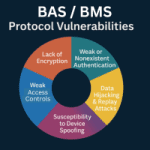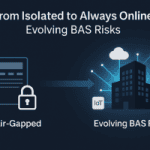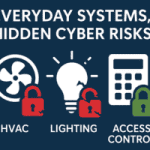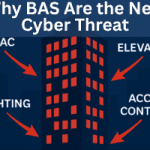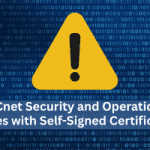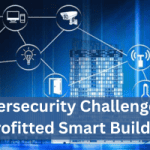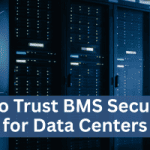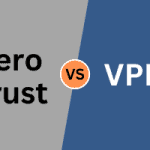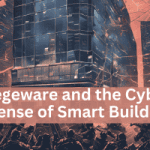Posts Tagged ‘Building Automation’
Top BAS/BMS Protocol Vulnerabilities
Quick Summary Legacy BAS/BMS protocols share common vulnerabilities, including no encryption, weak authentication, spoofing risks, replay attacks, and weak access controls. These flaws expose HVAC, lighting, and access systems to manipulation and disruption. Zero Trust, encryption, and device-level authentication can secure even legacy systems without costly replacement. Introduction Building automation systems (BAS) connect and control…
Read MoreFrom Air Gaps to Always Connected: The Evolution of Smart Building Cyber Threats
Quick Summary Smart building cyber threats have evolved alongside the shift from isolated, air-gapped BAS to always-connected systems. While connectivity boosts efficiency, it also exposes HVAC, lighting, and access controls to ransomware, weak protocols, and IT/OT convergence risks. To defend against these threats, facility managers must adopt Zero Trust and device-level security to ensure resilience.…
Read MoreThe Hidden Cyber Risks Inside HVAC, Lighting, and Access Control Systems
Quick Summary HVAC, lighting, and access control systems may appear harmless but can be exploited to cause serious operational, financial, and safety issues. These “hidden” risks arise from insecure protocols, lack of authentication, and poor segmentation. By adopting Zero Trust principles and device-level protection, facility managers and building operators can turn vulnerable systems into secure…
Read MoreWhy Building Automation Systems Are the New Cybersecurity Target
Quick Summary Building Automation Systems (BAS) are increasingly targeted by cybercriminals because they manage critical building functions such as HVAC, lighting, elevators, and access controls. Once considered safe due to isolation, BAS are now internet-connected and often insecure by design, making them gateways to both operational disruption and corporate IT networks. As cyberattacks on smart…
Read MoreOvercoming Niagara Framework Cyber Vulnerabilities
Key Points Comprehensive Vulnerability Mitigation: DOME encrypts all device communications, enforces unique cryptographic identities, blocks unauthorized actions, and prevents lateral movement even on flat networks—addressing risks like unencrypted data, credential hijacking, privilege escalation, and insecure configurations. Zero Trust at the Endpoint: Every enrolled device must authenticate and follow strict, policy-based access rules, ensuring only explicitly…
Read MoreBACnet Security and Operational Issues with Self-Signed Certificates
Key Points Security Risks Without Trusted Validation: Self-signed certificates lack third-party verification and a root of trust, making BACnet/SC systems vulnerable to spoofing, impersonation, and man-in-the-middle (MitM) attacks. Operational Complexity and Inefficiency: Managing self-signed certificates is time-consuming and error-prone, requiring manual generation, distribution (e.g., via USB), and renewal—especially problematic in large-scale deployments. Downtime and Renewal…
Read MoreCybersecurity Challenges in Retrofitted Smart Buildings
Key Points Legacy Systems Are Inherently Vulnerable: Most retrofitted buildings rely on outdated OT devices and insecure protocols (like BACnet and Modbus) that lack basic cybersecurity features such as encryption and authentication. Integration Increases Risk: Retrofitting often connects legacy OT systems to modern IT networks without proper segmentation, exposing buildings to lateral movement and cyberattacks.…
Read MoreZero Trust Security for Building Management Systems in Data Centers
Key Points Cooling and Power Risks: While power failures are the top cause of serious data center outages, 13–19% result from cooling issues, with notable incidents caused by extreme heat. Cyber Threats to Environmental Systems: Attackers can overheat servers via workload manipulation, compromise HVAC controls through DCIM systems, or sabotage power systems—causing performance loss, hardware…
Read MoreZero Trust vs Remote Access VPN for Building Control Systems
Zero Trust architecture fundamentally transforms how organizations secure their building automation networks by addressing the inherent vulnerabilities of traditional remote access VPN-based security. Key Points VPNs Grant Broad Access; Zero Trust Enforces Least Privilege: VPNs give authenticated users full network access, while Zero Trust limits each user or device to only the specific resources needed,…
Read MoreSiegeware and the Cyber Defense of Smart Buildings
Key Points Siegeware is a targeted cyber threat that exploits smart building systems (like HVAC, access control, and elevators) to extort building owners by locking them out or threatening disruption. Vulnerabilities include weak IoT security, outdated software, and poor network segmentation, all of which expand as buildings become more connected. Common reconnaissance tools like Shodan…
Read More
